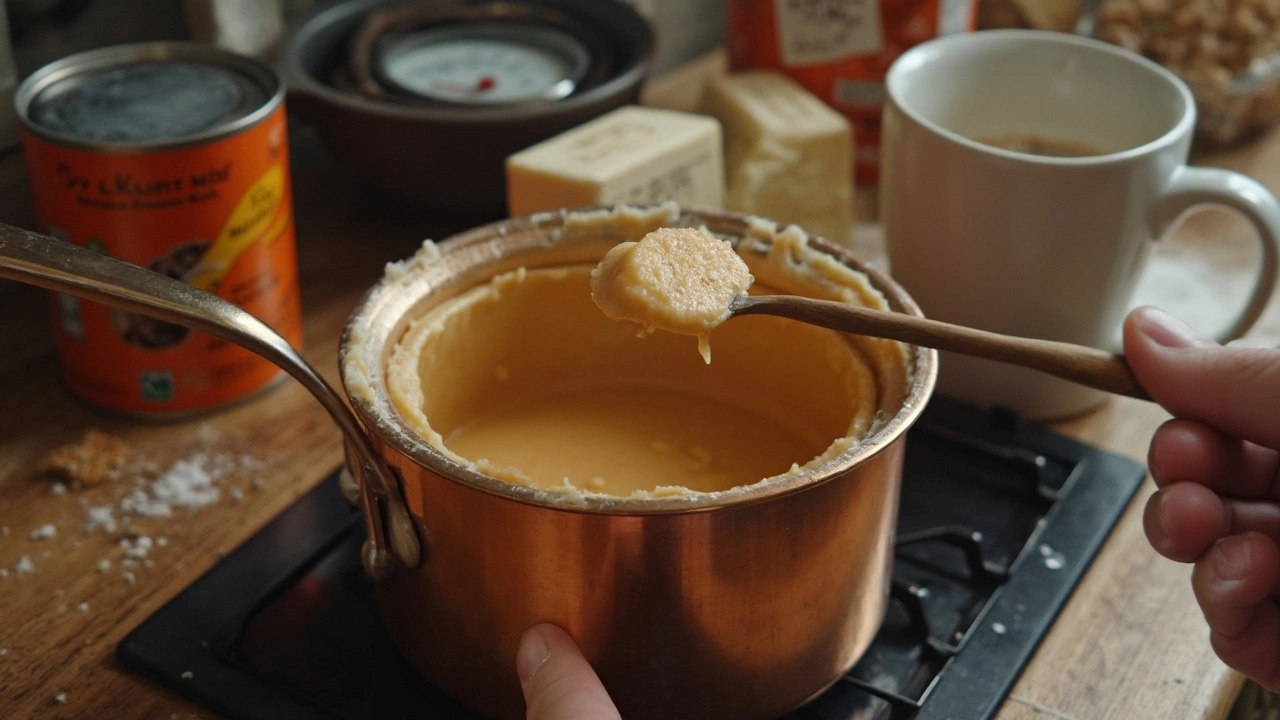
Ever poured your heart into homemade fudge, only to end up with a gooey blob that won’t hold its shape? You’re not the only one—fudge is kind of notorious for being tricky, especially when you use condensed milk. One small misstep, and suddenly that dreamy batch is a sticky, sugary disaster.
No need to toss it just yet. Fudge setting problems almost always come down to how you handle the basics—especially sugar temperature, ingredients, and timing. If your fudge with condensed milk isn’t firming up, there are only a handful of culprits. Usually, it’s either the mixture wasn’t boiled long enough or the ratio of ingredients is off.
Let’s get to the bottom of why your fudge is stuck in soft-land and walk through the simple steps to rescue it. Seriously, you don’t need a candy thermometer if you know what to look for. There are a few tricks that work every time—plus some mistakes everyone should avoid if you want those perfect, sliceable squares.
- What Really Makes Fudge Set?
- The Role of Condensed Milk in Fudge
- Common Mistakes That Ruin Fudge Texture
- How to Fix Fudge That Won’t Set
- Tips for Perfect Fudge Every Time
What Really Makes Fudge Set?
So, what’s the magic behind fudge actually setting up instead of staying squishy? It’s all about how sugar behaves as it cooks and cools. When you heat sugar with milk (or condensed milk), it dissolves and forms a syrup. As the mixture boils, water evaporates, making that syrup thicker. The longer you cook it, the less water remains, and the sugar concentration shoots up—which is exactly what you need for fudge to go from runny to rock-solid (well, not rock but you get me).
When you stop cooking at the right moment, you get a mixture that’s just the right thickness. If you stop too soon, there’s too much water, and your fudge won’t set, no matter how long it sits in the fridge. Too long on the stove, and you’ll end up with crumbly fudge or weird crystals everywhere. The sweet spot is what makes homemade fudge dreamy.
Here’s a quick table on sugar temperatures and what they mean for fudge texture:
| Stage | Temperature (°F) | What You Get |
|---|---|---|
| Soft Ball | 234–240 | Perfect for fudge and chewy candies |
| Firm Ball | 244–248 | Too stiff for fudge, more for caramels |
| Below Soft Ball | <234 | Won’t set, stays goopy |
But don’t worry—you don’t need to whip out a candy thermometer every time. The old-school “soft ball test” works: drop a little of the hot mixture in cold water. If it forms a soft, gooey ball that holds its shape, you’re there.
Besides the sugar, the amount of fat (from butter and condensed milk) makes a difference, too. Fat helps prevent gritty crystals and gives fudge that classic creamy feel. But too much and your fudge won’t set—it’ll totally flunk the slice test.
The most crucial move for fudge not setting is cooking it to the exact right stage and cooling it properly before you mix it for that smooth texture. Rush either one, and you’ll end up with fudge that’s either runny or as hard as a brick.
The Role of Condensed Milk in Fudge
If you’ve picked up a can of condensed milk for fudge, you’re probably after that rich, creamy texture. Condensed milk is milk that’s had most of the water cooked out and been sweetened with sugar—so it’s sticky, thick, and super sweet straight from the can. It gives fudge its soft bite without needing to mess with endless stirring or candy thermometers, especially for quick recipes.
Here's the thing: condensed milk doesn't actually help fudge set—that's the job of sugar. But condensed milk does make fudge smoother and gives it a more reliable texture because the mix is already partly thick and sugar-packed. Still, because it's all-in-one, you can’t just swap out ingredients or go rogue with quantities. If you change the ratios, your fudge can end up too wet or gritty.
Fudge recipes that use condensed milk depend on the right balance. Too much condensed milk, and you get sticky, floppy fudge. Too little, and it’s dry and crumbly. Here are the basics you need to know for getting it right:
- One standard can of condensed milk (about 14 ounces or 400 grams) usually calls for 2-3 cups of chocolate or other mix-ins.
- Stick to the recipe’s sugar and condensed milk amounts—don’t wing it.
- Mix until everything is combined and smooth. Don’t overbeat it after melting.
To give you an idea, check out how the standard ratios play out in most fudge recipes with condensed milk:
| Ingredient | Standard Amount |
|---|---|
| Condensed Milk | 1 can (14 oz/400g) |
| Chocolate Chips | 2-3 cups (340-510g) |
| Butter | 2-4 tablespoons (28-56g) |
| Salt/Flavorings | a pinch/to taste |
If your fudge not setting issues happen every time, double-check that you’re not loosening the mix with extra milk or skipping key ingredients. It’s tempting to experiment, but fudge is one place where the science matters more than the fun of improvising.

Common Mistakes That Ruin Fudge Texture
If your fudge isn't setting, it's probably because of something super common. Just one little issue with the process can mess up the whole batch. Don't worry—most problems are easy to fix once you know what they're all about.
- Rushing the Boil: If you don't boil the mixture long enough, it will stay soft no matter what. Fudge needs to reach a certain temperature, usually between 234°F and 239°F (112°C to 115°C). Skipping this step or eyeballing it almost always ends with a runny mess.
- Wrong Sugar Ratios: Using too much condensed milk or not enough sugar throws off the balance. The classic rule? At least 1 cup sugar for every can of condensed milk. Less than that and you'll end up with sticky, spoonable "fudge."
- Stirring at the Wrong Time: Stirring while the mixture is still cooking can make it grainy. Instead, leave it alone while it heats. Only stir once you've taken it off the heat and let it cool just a bit before beating until thick.
- Adding Extra Ingredients Too Early: If you dump chocolate or butter in before the sugar has had time to dissolve, you risk seizing up the mixture. Add those extra goodies only when the base is smooth and ready.
- Humidity Messes Everything Up: Fudge hates wet weather. On a humid day, the extra moisture in the air gets into your mixture and can make it so your fudge not setting turns into a regular thing.
Here's a quick check—see how the mistakes line up with common fudge fails:
| Mistake | What Happens | Easy Fix |
|---|---|---|
| Didn’t boil mix long enough | Fudge stays gooey, doesn’t set | Return to pot, boil to 235°F, then reset |
| Wrong sugar-to-condensed milk ratio | Too soft or never solidifies | Add more sugar, reheat to correct temp |
| Stirred while hot | Grainy, sandy texture | Wait to stir until off heat and slightly cooled |
| Added mix-ins too soon | Mixture goes weird or splits | Always add extras after main mix is smooth |
| Made fudge on a humid/rainy day | Sticky, never sets | Try again on a dry day or use a dehumidifier |
Next time, just keep an eye on these points. Little habits make a big difference when it comes to fudge texture!
How to Fix Fudge That Won’t Set
So your fudge is more like a sauce than a square. Don’t panic. This happens all the time with fudge made from condensed milk. There are a couple of ways to save that stubborn batch, and you might not even need to start from scratch.
The main reason fudge won’t set is that the sugar mixture wasn’t cooked long enough. Fudge needs to hit the so-called “soft-ball” stage—around 234 to 240°F (112 to 115°C). Without a thermometer, you can still test a bit by dropping it into cold water; if it forms a soft, squishy ball, you’re there. But if you’ve already poured and cooled it, here’s what to try next:
- Put It Back on the Stove: Scrape the unset fudge back into your pot. Add a splash of water or condensed milk if it’s thick. Reheat gently and stir constantly. Bring it up to a rolling boil and let it cook until it hits that soft-ball stage. Take it off the heat, beat it until it thickens, then pour and cool again. Most of the time, this does the trick.
- Try the Freezer: If you’re in a rush and your fudge is barely too soft, stick it in the freezer for an hour. It might not fix the chemistry, but it’ll hold together enough to slice and serve.
- Repurpose Your Fudge: If nothing works, turn it into something else. Use it as a sauce for ice cream, swirl it into brownies, or make fudge truffles—just roll balls of the fudge and dip in melted chocolate. Waste not!
Ever wonder how often people run into trouble with fudge? Here’s what folks usually face with fudge not setting made with condensed milk:
| Reason | How Common (Est. % in Home Kitchens) | Quick Fix |
|---|---|---|
| Not cooked long enough | 60% | Reboil and test soft-ball stage |
| Too much liquid (milk, butter, flavorings) | 25% | Reboil, add sugar |
| Too little sugar | 10% | Re-melt, add sugar |
| Poor cooling/mixing | 5% | Beat longer, use proper pan |
If you’ve tried these fixes and still have soft fudge, it usually points to a recipe issue—like too much condensed milk versus sugar. Next time, double check your ratios and don’t skip that boiling step. Fudge can sense fear, so show it who’s boss!

Tips for Perfect Fudge Every Time
If you’re ready to level up and stop guessing, these tips will bump up your fudge game—no matter how many batches have gone sideways. These aren’t old wives’ tales; they come straight from kitchens where fudge not setting is a thing of the past.
- Use the right pan. Heavy-bottomed pans heat more evenly and help prevent burning or hotspots that can mess up your sugar melt. Nonstick is fine, but don’t grab anything too thin.
- Watch your ratios. Double-check your ingredient measurements, especially the condensed milk and chocolate. Too much milk, and you’ll end up with fudge sauce instead of squares.
- Don’t skip the boil. Bring your mixture to a full rolling boil for 4-5 minutes. If you don’t hit that stage, your fudge won’t set. Stir constantly! Sugar burns fast.
- Check the soft ball stage. If you have a candy thermometer, aim for about 234°F (112°C). No thermometer? Drop a bit of the mixture into cold water. It should form a soft, gooey ball.
- Chill right. Line your pan with parchment so the fudge pops out clean. Let it cool at room temp for about an hour, then chill in the fridge. Don’t rush it in the freezer—it can dry out and get weirdly crumbly.
- Don’t overmix. When you add extras (like nuts or marshmallows), fold them in quickly and gently to avoid turning the whole thing gritty.
One last thing—store your fudge right. Airtight containers in a cool spot (not the fridge) keep it smooth and sliceable for days. Homemade fudge is basically science plus patience, so keep practicing. Next time, that perfect batch will be yours.